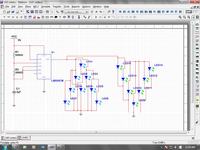Englewood
Full Member level 3
I want to make a running light of LEDS though a NAME.
Lets say ENGLEWOOD
Each letter will take 10 LEDS make and i want each letter to flash in a running sequence.
Is it possible to run a 90 LEDS off 1 555 timer?
Or will i need a timer for each letter?
Will this run off a 5v supply or would i need 9V.
90 x 20ma 1800ma for the current for LEDS.
I will run the LEDS in parallel
Lets say ENGLEWOOD
Each letter will take 10 LEDS make and i want each letter to flash in a running sequence.
Is it possible to run a 90 LEDS off 1 555 timer?
Or will i need a timer for each letter?
Will this run off a 5v supply or would i need 9V.
90 x 20ma 1800ma for the current for LEDS.
I will run the LEDS in parallel
